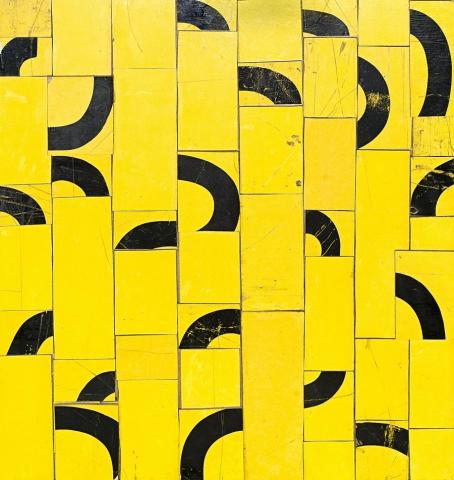BANANA YELLOW, 1998
ROSALIE GASCOIGNE
retro-reflective road sign on plywood
70.0 x 63.0 cm
signed, dated and titled verso: Rosalie Gascoigne / 1998 / BANANA YELLOW
Rosyln Oxley9 Gallery, Sydney
Private collection, Brisbane
'As I go through my processes of driving and looking and happening upon and selecting and hauling home and scrubbing and hack sawing, removing nails and cutting tin, I often cast a wistful eye at the painter who fronts up to a clean canvas with his paint and brushes.'1
Banana Yellow was among one of the last retro-reflective road sign works Rosalie Gascoigne composed just before her death in 1999. She had stumbled across her first group of road signs near the depot at Collector in New South Wales in the early 1980s and she began to stockpile these brightly coloured signs, gathering them during her regular driving expeditions in search of discarded materials for her not insubstantial studio inventories. The finding of these yellow and orange retro-reflective signs, along side her towering haul of Schweppes boxes from Queanbeyan, was a seminal moment in Gascoigne's art. From there on she ceased to make her three-dimensional assemblages and worked exclusively on these quasi-flat wall pieces. The sorting and cleaning, cutting and selecting of each component in these works was a laborious and by and large physical activity requiring the help of her astronomer husband and various studio assistants. Once Gascoigne chose each component then followed her measured process of arrangement. As her long-time studio assistant Peter Vandermark commented, 'Her hands were always moving things around, her eyes always assessing the arrangements her hands made. She'd say her art was seeing, watching and trying out.'2 The artist and fellow studio assistant Marie Hagerty added, 'her art was embedded in the process of seeing or shaping'.3
Born in New Zealand to an academic family in 1917, it was not until her fifties, through her significant love of nature, that Gascoigne realised she was an artist. Originally trained in Ikebana to pass the lonely times living on Mount Stromlo near Canberra, her expertise in the gentle art of Japanese flower arrangements was renowned. This discipline and her keen sense of observation quite possibly underpinned the remarkable knack she had in finding beauty in nature's off cuts and using the discarded and overlooked to astonishing capacity in her later art. When she finally became an artist in the early 1970s success came rapidly and her first solo exhibition at Macquarie Galleries in Canberra and her next show at Gallery A in Sydney were embraced with critical acclaim. In 1982 her significant contribution to Australian art was recognised when she represented Australia at the Venice Biennale.
1. Gascoigne, R., Art Monthly Magazine, September 1987, quoted in Macdonald, V., Rosalie Gascoigne, Regaro, Sydney, 1998
2. Eagle, M. (ed.), From the Studio of Rosalie Gascoigne, The Australian National University, Canberra, 2000, p. 20
3. Ibid.
LARA NICHOLLS
